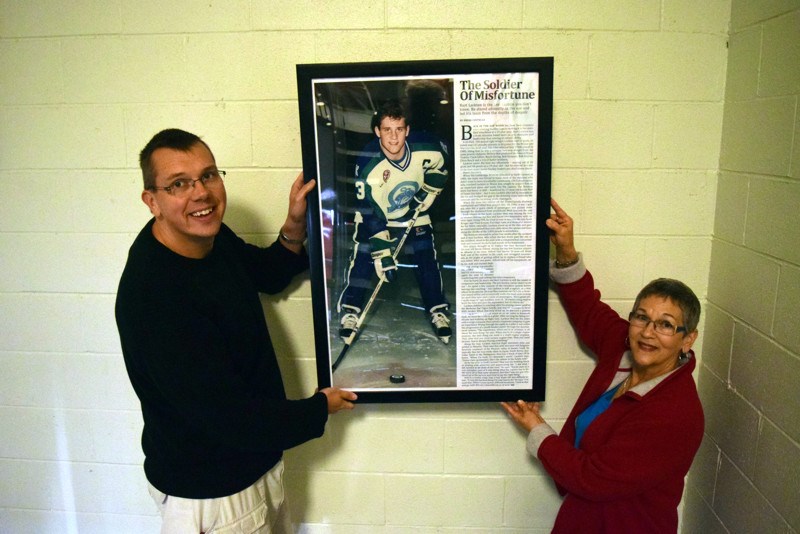A poster of a former Kamsack resident with a distinguished career in hockey has been added to the display of home-grown sports celebrities at Broda Sportsplex.
Last week, Joe and Gladys Lackten of Kamsack presented a large, framed photograph of their son Kurt with an accompanying article from The Hockey News to Kev Sumner, Kamsack’s recreation director. It was to be hung on the wall in the stairwell leading up to the mezzanine floor.
After beginning his hockey career with the Kamsack Minor Hockey Association, Lackten played with the Notre Dame Hounds, the Swift current Broncos of the Western Hockey League and was drafted by the New York Islanders of the National Hockey League. He had distinguished himself in 1986 when, as the captain of the Broncos, he was involved in the team’s bus crash that had claimed the life of four of his teammates.
A resident of Phoenix, Arizona, where he lives with his wife, Julie and daughter Kennedy, Lackten, who is a former Kamsack air cadet, currently works as a pilot for Hawaiian Airlines.
The story from The Hockey News which accompanies Lackten’s photo in the poster was re-printed in the January 24, 2013 issue of the Kamsack Times. Following are excerpts from that story which was originally written by Brian Costello of The Hockey News.
“Back in the day when the New York Islanders were winning Stanley Cups or making it to the semifinal nine times in a 10-year span, Kurt Lackten was a draft selection based more on grit, character and leadership than scoring or natural ability.
“A six-foot, 180-pound right winger, Lackten had 18 goals, 31 points and 141 penalty minutes in 66 games for the Moose Jaw Warriors his draft year. The Isles selected him 139th overall in 1985, liking that he was a scappy, two-way winger from the same prairie character factory that produced the likes of Bryan Trottier, Clark Gillies, Butch Goring, Bob Nystrom, Bob Bourne, Chico Resch and a trio of Sutter brothers.
“Lackten never did bust out offensively, maxing out at 20 goals and 40 points as a 19-year-old, but he evolved into one of the best major junior hockey leaders you don’t know about.
“Here’s the story.
“When the Lethbridge Broncos relocated to Swift Current in 1986, the team was forced to trade most of the veterans who didn’t want to move to a smaller community. GM Graham James, who coached Lackten in Moose Jaw, sought to acquire him as an important piece and made him the captain. The Broncos were top-heavy in skill, headlined by 17-year-old future Hall of Famer Joe Sakic, but it was Lackten who led by example on the ice and bridge the gap in the dressing room between the veterans and the incoming youth contingent.
“When the team bus veered off the Trans-Canada Highway, overturned and killed four players on December 30, 1986, it was Lackten who did a quick check of passengers and guided them through the shattered front windshield. With bruised ribs and a fresh whack on the head, Lackten then was among the first to venture behind the bus and found two teammates with no vital signs. Using CPR, he tried in vain to breathe life into Scott Kruger and Trent Kresse. Five days later, at a memorial service for his fallen comrades, Lackten stood up at the dais and gave an emotional send off that sent chills down the spines and tears along the cheeks of the 3,000 people in attendance.
“The Broncos returned to action two weeks after the accident and it was Lackten, who when the bus drove past the site of the accident, stood in the aisle with a composed but concerned look and scanned the faces and moods of his teammates.
“One player brought into replace the four deceased was 16-year-old David Aldred, among the top few bantam players in Alberta at the time. Aldred had known 16-year-old Brent Ruff, one of the victims in the crash and struggled emotionally at the plight of getting called up to replace a friend who was killed. After one game, Aldred took off his equipment, sat in his stall and started shaking and crying uncontrollably. Within seconds, Lackten had his arm around him and spent the next 15 minutes comforting him and talking him into composure.
“Fast forward 26 years and Kurt Lackten is still the model of composure and leadership. The pro hockey career didn’t work out; he spent a few seasons in the Islanders’ system before moving into coaching, but Lackten is still a captain, or a first officer to be precise. He now flies commercial 767s for a Honolulu-based airline and occasionally walks the main aisle locking his steel-blue eyes and a smile on passengers.
“Lackten dabbled in coaching after his playing career, guiding the Medicine Hat Tigers briefly, and was an assistant in three WHL locales. When that field dried up, he pursued a passion that was borne as a youth when as an air cadet in Kamsack, he went for a ride in a glider. After earning his flying certificate and building up flight time, Lackten flew for five years with a cargo company, then joined a corporate company to gain jet experience. Rising through the ranks as a pilot is not unlike the progression of a youth hockey player through the development system.
“Along the way, Lackten married Julie, a flight attendant, and settled in Phoenix. He typically flies for two-week stints to Japan, South Korea, Australia, Tahiti or the Philippines, then has a block of days off at home.”




